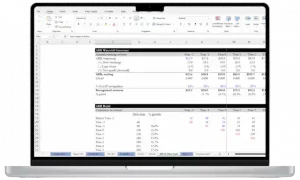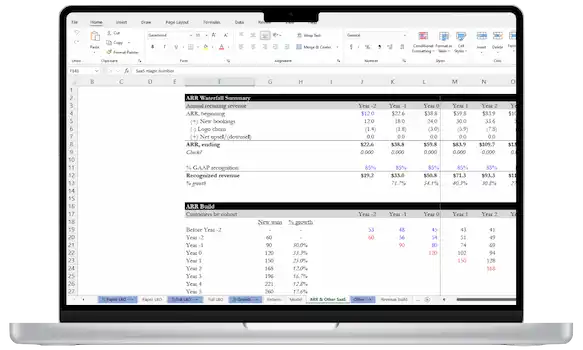If you have a basic knowledge of accounting, you know about the revenue recognition principle.
This principle states that revenue is recognized in the period when it is earned, and not necessarily in the period when it was received.
Utilizing this principle in your company’s accounting helps “even out” revenue received throughout the year.
With this basic principle in mind, how does this apply specifically to SaaS companies?
What is SaaS Revenue Recognition?
SaaS companies often have revenue from multiple sources – primarily ARR, but also onboarding fees, usage fees if clients exceed their plan usage, custom plans, and more.
Since revenue recognition requires that the revenue be recorded as income when it is earned, this can present a challenge for SaaS companies, who “earn” revenue at non-standard time periods.
Challenges like these are why the Financial Accounting Standards Board (FASB) and the IASB (International Accounting Standards Board) created ASC 606. This guideline is not specifically limited to SaaS companies, but offers additional instructions for accurately matching revenue to the actions that earned it.
ASC 606 offers five steps to correctly assign revenue to the right period:
- Identify the contract
- Identify the performance obligation(s)
- Identify the transaction price
- Allocate the transaction price
- Recognize allocated revenue
We’ll look more at how this looks for SaaS companies specifically later.
How Do You Recognize Revenue for an SaaS Company?
Basic revenue recognition for SaaS companies is easy: divide ARR into MRR for each month in the life of the contract.
This is the useful thing about accrual accounting and SaaS: it is fairly easy to track monthly revenue from accounting with MRR.
The general principle is that annual subscription prepayments have to be recognized over the full year of the contract.
One-time services or onboarding fee revenue can be recognized at the time of service.
Upsells, cross-sells, and downgrades that involve recurring revenue will need to be specially calculated to be recognized appropriately.
How do I Book SaaS Revenue?
If your customers generally pay on a monthly basis, there’s no problem translating MRR into GAAP revenue for the month.
However, annual or one-off revenue has to be analyzed before it can be booked. Multi-year contracts may present additional challenges – does the customer pay for a two-year commitment ahead of time, leaving unearned revenue as a liability on the books at year-end?
Or does the customer sign a two-year contract, but only pay for a year at a time? Upsells and cross-sells may be recognized all at once in a month, or increase MRR over time – it depends on the nature of the service or product sold.

- 33 lessons
- 8+ video hours
- Excels & templates
Revenue Recognition Scenarios for an SaaS Company
Suppose a new client comes on board in January, and pays $6,000 for a year’s subscription. Is this all recognized in January? No. Instead, the company recognizes the $6,000 as the following:
Cash $6,000
Revenue $500
Unearned Revenue $5,500
Then, in February, the next month’s revenue is recognized. The balance of the Unearned Revenue account is reduced by the amount that was earned that month, and the next month’s MRR is transferred to Revenue.
Unearned Revenue $500
Revenue $500
This process continues throughout the year until all the revenue is recognized as earned each month. Spreading out the revenue over the time of the service provided protects both the company and the customer.
Suppose, for instance, that the client decides halfway through the year to cancel their subscription. If you had recognized all of their upfront payment as revenue for your business, you would have to write a loss into your books in order to pay back your client the money they were due.
Keeping the unearned portion of the payment in the unearned revenue “bucket” essentially lets you and your accounting team know that you “owe” your customer a debt in the form of the work or service they paid for.
Now, let’s add some extra factors to the equation.
In addition to the $6,000 year’s subscription, the client also paid a one-time onboarding fee of $250. In July, they also exceeded their subscription plan usage for the month and paid additional overage fees of $75. Total projected revenue from this contract initially came to $6,325.
Now it’s time to apply some of the principles in ASC 606.
The first step: identify the contract.
The contract is clear; the yearly price and all related fees were built into the software terms and conditions.
Next, identify the performance obligation.
The SaaS company has the responsibility to provide the customer with the software access they subscribed to (the yearly subscription). It also has the responsibility to educate the customer about the software (onboarding fees) and meet the customer’s increased software needs (overage fees).
This is where the revenue from this contract can be separated. Each of these responsibilities was met at a different time over the course of the year. The onboarding fee can be recognized in full as revenue in January, as the performance obligation tied to that payment was completed in January. The overage fees can be recognized in full in July, as the responsibility tied to that payment was completed in July.
Suppose that this same customer also decided in October that year to downgrade their subscription to a lower plan that was only $250 per month for the rest of the year, instead of $500. Now, instead of needing to recognize an additional $1,500 in revenue for the year, the company only needs to recognize $750.
They will have to decide with the customer whether they will refund the balance of the subscription funds, or apply it toward a future three months’ service from the company.
To sum up, the revenue that was recognized each month in this scenario looks like:
January: $750
February: $500
March: $500
April: $500
May: $500
June: $500
July: $575
August: $500
September: $500
October: $250
November: $250
December: $250
Total: $5,575
As you can see, revenue recognition allows you to create a realistic timeline for the company’s – and customer’s – financial activities throughout the year.
Another common scenario involves upsells.
An upsell that adds to MRR, such as a plan with higher usage, will mean a higher recognized revenue each month. An upsell that creates an entirely new service, such as personalized consulting services, may be categorized as a separate income stream on the books.
The customer may still make a single payment each month, but the revenue must be recognized as belonging to separate services.
How Does ASC 606 Affect SaaS companies?
ASC 606 simply gives SaaS companies a way to structure their revenue recognition for maximum accuracy.
The majority of SaaS revenue has a clear correlation between money earned and service rendered over time, making revenue recognition straightforward.
As we saw in our examples, ASC 606 helps clarify revenue recognition in special circumstances that deviate from the steady MRR model.
SaaS companies are unique in that they offer a blended product and service model. The old model of software purchasing, where the customer bought the software, took home the CD-ROM, and loaded it onto their computer, made it clear when the revenue could be recognized: at or after time of purchase.
Alternatively, a subscription-based business such as a magazine subscription has a clear delivery period for each issue. Finally, a service business recognizes revenue after the service has been rendered. SaaS companies have elements of all of these. Their software is available for customers’ use after purchase, but the customer does not actually own the software they use.
The subscription price simply guarantees the continued use of the service, without having a concrete point of reference like a magazine sent in the mail. Similarly, the software is simply made available to the customer without specific services rendered.
SaaS companies may offer related services such as consulting that do have specific services rendered, but the general idea here is that SaaS offerings often do not fall neatly into established revenue recognition boxes. The ASC 606 guidelines offer more clarity into the recognition rules for digital products and services where no tangible product or service is exchanged.
Go Deeper
Want to take your SaaS knowledge to the next level? Join my online course on SaaS metrics and financial modeling — it’s the most comprehensive course for investors.


 SaaS & Growth Metrics
SaaS & Growth Metrics Break Into Growth Equity
Break Into Growth Equity
